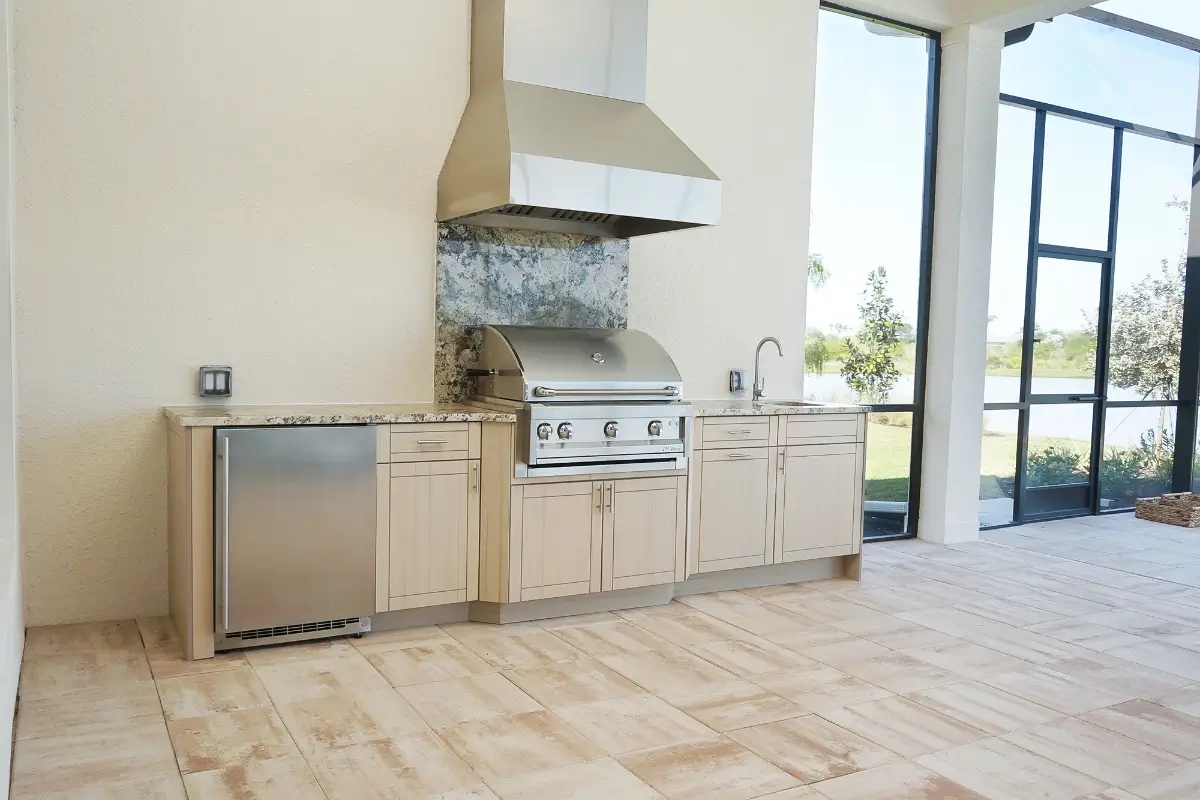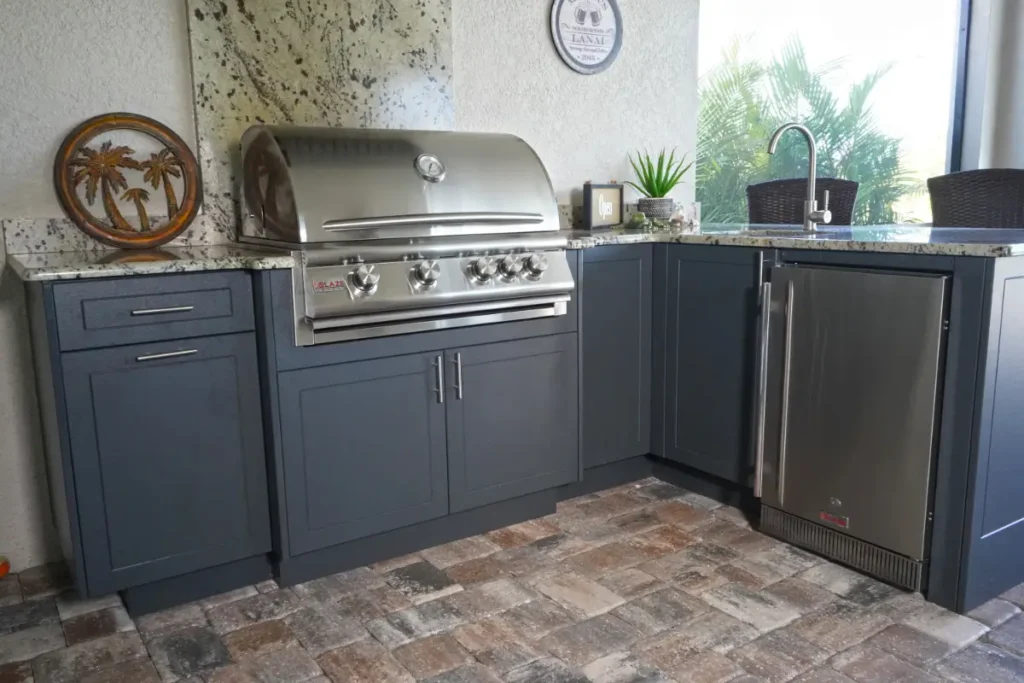
Outdoor Cabinets for Patios: What to Know Before You Buy
Adding outdoor cabinets to your patio isn’t just about storage. It’s about extending your living space, creating a seamless flow between indoor and outdoor areas, and choosing materials that can hold up to sun, salt, humidity, and temperature swings. Whether you’re building a full outdoor kitchen or upgrading a grilling nook, outdoor cabinetry plays a major role in function and design. At Calico Outdoor, we design and install fully customized outdoor kitchens across Jacksonville, and proper cabinetry is one of the first things we consider.
Table of Contents
Know Your Climate, and Choose Materials That Match It
Patio cabinets might look similar to their indoor counterparts, but treating them the same way is a fast track to failure. Jacksonville’s coastal humidity, intense UV rays, and seasonal storms demand materials that can take a beating. Not all “weatherproof” options live up to the name, especially when exposed year-round to salty air and heavy rain.
Marine-grade polymer (HDPE), powder-coated aluminum, and 304 or 316 stainless steel are the top-tier choices here. These materials resist rust, swelling, fading, and warping. Wood, even when treated, typically struggles over time in our climate. PVC alternatives might seem appealing price-wise, but they’re prone to cracking and discoloration.
Beyond weather resistance, material choice affects cleaning and maintenance. Stainless steel has a sleek look but can show fingerprints and smudges. Polymer is lower-maintenance and won’t show wear as quickly. Powder-coated aluminum can give you color flexibility with solid protection.
Cabinet Design Isn’t Just About Storage
The way you design and layout your outdoor cabinets impacts how you cook, entertain, and move around the space. A common mistake is treating patio cabinetry like an afterthought. Poor placement or underestimating how much storage you need leads to cluttered countertops and frustrated hosts.
Think about how you actually use the space. Will your cabinets house utensils, grill tools, trash bins, or serve as dry storage for pantry-style items? Is there a sink or fridge nearby that needs undercounter support? Are you trying to hide a propane tank or create pull-out drawers for ice coolers? These decisions shape your cabinetry configuration.
Also think about access. Soft-close doors and drawers, pull-out shelving, and corner cabinet solutions make a big difference when your hands are full or you’re prepping food. Venting is also key for safety if you’re enclosing any gas-powered appliances.
Plan for Utilities Before Installation
Outdoor cabinets often surround appliances, sinks, or other features that require electrical, water, or gas hookups. All too often, homeowners get excited about the layout only to realize they’re boxed in by utility limitations. Cabinets should be placed with future access in mind—not just for daily use, but for servicing and winterizing equipment.
If you’re planning an outdoor sink, you’ll need to consider how water supply and drainage will run to that area. For refrigeration or kegerators, cabinets should allow for ventilation and easy reach to power outlets. Grills or side burners fed by natural gas or propane need open airflow and safe clearances. Planning these elements up front avoids costly modifications later.
Style Matters—But It Has to Last
Outdoor cabinets help define the look of your patio kitchen. Just like indoors, finishes, colors, and hardware choices influence the overall feel. Modern, coastal, farmhouse, or classic—whatever direction you take, durability still needs to be the foundation.

Powder-coated aluminum gives a range of color options that won’t fade like paint or vinyl wraps. Some manufacturers offer woodgrain finishes that mimic teak or walnut, but they’re backed by tough metal cores. Marine-grade polymers are more limited in color but offer solid, UV-stable options that look clean and modern.
Handles, hinges, and latches should all be marine-grade or sealed stainless steel. Anything less will corrode quickly in Jacksonville’s salt air. Frameless designs offer a clean profile and slightly more interior space, while framed cabinets are easier to level on uneven patio surfaces.
Think About What’s Above and Around Your Cabinets
Outdoor cabinets don’t live in a vacuum. What’s above them—awnings, pergolas, or full covers—affects their exposure to rain and sun. Cabinets under full shade can sometimes get away with less heavy-duty materials, but in most Florida backyards, full sun and storms are the reality.
Cabinet bases should sit on solid foundations. Pavers, concrete pads, or properly built decks provide level, dry support. Avoid placing cabinets directly onto soil or untreated wood, as moisture wicks upward and damages the frames over time.
Also consider what surrounds your cabinets: grills, smokers, pizza ovens, or open flames all generate heat. Nearby cabinet materials should be rated for heat resistance, with non-combustible panels or insulated liners when needed.
Installation Isn’t a DIY Job for Most Homes
Unlike installing a cabinet indoors, outdoor cabinet installation demands precision, patience, and an understanding of how to work with sloped surfaces and irregular patio layouts. Leveling across stone pavers or uneven decks can be tricky. So can anchoring cabinets securely without compromising waterproofing or existing finishes.
If appliances are part of the setup, installation becomes even more technical. Ensuring clearance, airflow, and safe connections to gas or electric lines is critical. Add to that the sealing requirements for drawers and doors to keep out insects and water, and this quickly moves into professional territory.
Hiring pros who specialize in outdoor kitchens helps you avoid shortcuts that might cost more later. A well-installed cabinet setup looks clean, functions properly, and lasts for years without constant tweaks.
Wrap-Up: Plan With Durability, Function, and Flow in Mind
Outdoor cabinets can transform a patio into a functional, inviting kitchen and entertainment space. But cutting corners on materials, layout, or installation is a recipe for disappointment. Jacksonville’s climate demands quality, and smart planning up front pays off long-term.
Start with how you’ll use the space, then match that with cabinet materials built to last. Think beyond storage and into how cabinets integrate with appliances, seating areas, and covers. Done right, your outdoor cabinets won’t just store tools—they’ll support great meals, smooth hosting, and effortless outdoor living.
If you’re ready to map out your outdoor kitchen project in Jacksonville, Calico Outdoor brings years of experience crafting custom spaces designed to handle Florida’s heat, salt, and humidity—without sacrificing style or comfort.
